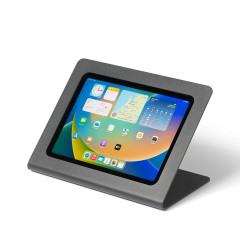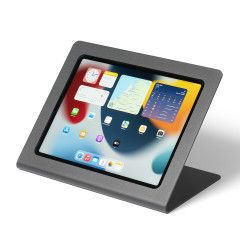
Tablets in retail
There are many ways that tablets are being used in retail settings to enhance the shopping experience and improve operational efficiency. Some examples include:
- Providing self-service kiosks for checkout, returns, or customer service inquiries
- Displaying interactive product information or promotional materials
- Omnichannel retail: allowing customers to browse and purchase products online while in the store
- Collecting customer feedback or conducting surveys
Tablets can be used in a variety of different locations within a retail store, such as at the point of sale, in fitting rooms, or in display areas. They can also be mounted in tablet enclosures or placed on stands or countertops to make them easily accessible to customers. By leveraging the capabilities of tablets, retailers can create a more engaging and personalized shopping experience for their customers.
Self Service Kiosk
A tablet-based self-service kiosk is a kiosk that uses a tablet computer, such as an iPad or Android tablet, as the primary interface for users to interact with. These kiosks are often used in public or shared spaces, such as retail stores, airports, museums, or hospitals, to provide information, access services, or facilitate transactions.
Tablet-based self-service kiosks can be configured to display a variety of interactive content, such as a website, a digital signage presentation, or a custom app. They may also be equipped with additional hardware, such as card readers, touchscreens, or printers, to enhance the user experience and enable specific functionality.
Interactive product information
Interactive product information refers to digital content that provides information about a product and allows users to interact with it in some way. This can include text, images, videos, animations, or other multimedia elements, as well as interactive features such as menus, buttons, or sliders.
Interactive product information can be displayed on a variety of devices, such as tablets, smartphones, laptops, or kiosks, and can be accessed in a variety of ways, such as through a website, an app, or a digital signage system.
There are many benefits to providing interactive product information to customers. For example, it can:
- Help customers understand the features and benefits of a product
- Allow customers to explore a product in more depth, such as by viewing additional images or video demonstrations
- Enable customers to customize or configure a product to meet their specific needs
- Provide customers with additional information, such as care instructions or warranty information
- Encourage customers to engage with a product and increase their likelihood of making a purchase
Interactive product information can be particularly useful in retail settings, where customers may have limited time to interact with products in person. By providing interactive product information, retailers can give customers a more immersive and convenient way to learn about products and make informed purchasing decisions.
Omnichannel retail
Omnichannel retail refers to a strategy for providing a seamless and consistent shopping experience to customers across all channels, including online, mobile, brick-and-mortar stores, and social media. The goal of omnichannel retail is to create a cohesive and integrated customer journey, regardless of how or where customers choose to shop.
To implement an omnichannel retail strategy, businesses need to adopt a customer-centric approach and focus on providing a consistent and convenient experience across all channels. This can involve integrating customer data and feedback from multiple channels, creating a consistent brand experience, and offering a wide range of fulfillment options, such as in-store pickup, home delivery, or curbside pickup.
Some examples of how omnichannel retail can be implemented include:
- Providing a single view of inventory across all channels, so that customers can see which products are available and where they can be purchased
- Offering personalized and relevant recommendations and promotions based on customer data and behavior across channels
- Allowing customers to start a purchase online and finish in-store, or vice versa
- Enabling customers to use their mobile devices to access additional product information, reviews, or recommendations while in-store
- Providing a range of payment options, such as mobile payments, in-store checkout, or online checkout
By adopting an omnichannel retail strategy, businesses can create a more seamless and convenient shopping experience for their customers, and improve their chances of building long-term customer loyalty.
Conducting surveys
There are several ways to conduct surveys using tablets:
-
Create a survey using a survey software or service, such as Google Forms, SurveyMonkey, or Qualtrics. You can then display the survey on the tablet using a web browser or a dedicated app.
-
Use a survey app specifically designed for tablets, such as SurveyGizmo, QuickTapSurvey, or Survey123. These apps allow you to create and distribute surveys directly from the tablet, and often include features such as offline support, GPS tracking, and multimedia capabilities.
-
Use a survey tool that integrates with a tablet-based self-service kiosk. For example, you can use Kiosk Pro or Enplug to create a kiosk that displays a survey for users to complete.




